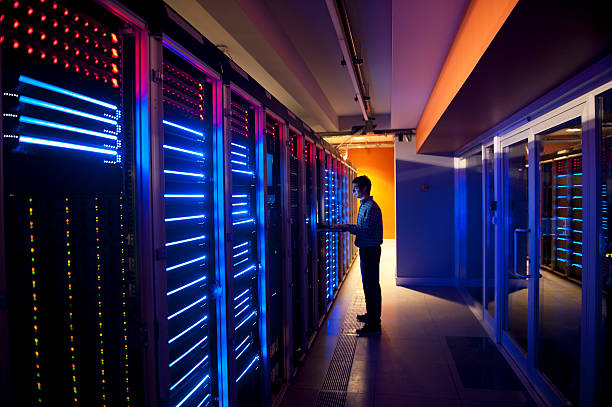Understanding Information Systems: A Comprehensive Guide
Introduction to Information Systems
In today's digital age, the term "information system" encompasses a broad range of technologies and methodologies designed to manage, process, and store information. At its core, an information system is a coordinated set of components that work together to collect, process, store, and disseminate information. These systems are integral to the functioning of modern organizations, playing a crucial role in decision-making, operational efficiency, and strategic planning.
The Components of an Information System
An information system typically comprises several key components: hardware, software, data, people, and processes. Hardware includes the physical devices such as computers, servers, and networking equipment that are essential for running the system. Software consists of the applications and operating systems that process data and provide functionality. Data represents the raw facts and figures that are processed to generate meaningful information. People are the users who interact with the system, ranging from end-users to IT professionals who manage and maintain the system. Processes are the procedures and workflows that govern how information is handled and used within the system.
Types of Information Systems
Information systems can be categorized based on their purpose and scope. Transaction Processing Systems (TPS) handle the routine transactions necessary for day-to-day operations, such as processing sales and payroll. Management Information Systems (MIS) are designed to provide managers with the information needed for decision-making and control, often using data from TPS. Decision Support Systems (DSS) assist in making complex decisions by analyzing large amounts of data and providing insights. Executive Information Systems (EIS) offer top executives a high-level overview of the organization's performance through dashboards and key performance indicators.
The Role of Information Systems in Organizations
Information systems are pivotal in modern organizations, supporting a wide range of activities from administrative tasks to strategic planning. They enable businesses to streamline operations, improve communication, and enhance customer service. By automating routine tasks, information systems free up human resources for more strategic activities. Additionally, they facilitate better decision-making by providing timely and accurate information. The integration of information systems into various business processes helps organizations achieve greater efficiency, productivity, and competitive advantage.
Challenges in Implementing Information Systems
Implementing an information system can be a complex and challenging endeavor. One of the primary challenges is ensuring that the system aligns with the organization's goals and processes. This requires careful planning and analysis to identify the specific needs and requirements of the organization. Another challenge is managing the change associated with the introduction of a new system. Employees may resist adopting new technologies, and there may be a learning curve associated with using the system effectively. Additionally, information systems must be secure to protect against data breaches and cyber-attacks, which requires robust security measures and ongoing vigilance.
The Evolution of Information Systems
Information systems have evolved significantly over the years, driven by advancements in technology and changing business needs. Early information systems were primarily focused on automating routine tasks and processing transactions. As technology advanced, the scope of information systems expanded to include more sophisticated capabilities such as data analysis, artificial intelligence, and cloud computing. The rise of the internet and mobile technologies has also transformed information systems, enabling real-time communication and data access from anywhere in the world.
Future Trends in Information Systems
Looking ahead, several trends are likely to shape the future of information systems. The increasing use of artificial intelligence and machine learning will enable systems to provide more advanced analytics and automation. The growth of big data will lead to more powerful data processing and analysis capabilities, allowing organizations to gain deeper insights from their data. Additionally, the expansion of the Internet of Things (IoT) will result in more interconnected systems and devices, creating new opportunities for data collection and analysis. As information systems continue to evolve, organizations will need to stay abreast of these trends to remain competitive and effectively leverage their information assets.
Conclusion
Information systems are fundamental to the operation and success of modern organizations. They provide the tools and infrastructure necessary to manage, process, and utilize information effectively. As technology continues to advance, the capabilities and applications of information systems will expand, offering new opportunities and challenges. By understanding the components, types, and role of information systems, organizations can better harness their potential to drive growth and innovation.
Introduction to Information Systems
In today's digital age, the term "information system" encompasses a broad range of technologies and methodologies designed to manage, process, and store information. At its core, an information system is a coordinated set of components that work together to collect, process, store, and disseminate information. These systems are integral to the functioning of modern organizations, playing a crucial role in decision-making, operational efficiency, and strategic planning.
The Components of an Information System
An information system typically comprises several key components: hardware, software, data, people, and processes. Hardware includes the physical devices such as computers, servers, and networking equipment that are essential for running the system. Software consists of the applications and operating systems that process data and provide functionality. Data represents the raw facts and figures that are processed to generate meaningful information. People are the users who interact with the system, ranging from end-users to IT professionals who manage and maintain the system. Processes are the procedures and workflows that govern how information is handled and used within the system.
Types of Information Systems
Information systems can be categorized based on their purpose and scope. Transaction Processing Systems (TPS) handle the routine transactions necessary for day-to-day operations, such as processing sales and payroll. Management Information Systems (MIS) are designed to provide managers with the information needed for decision-making and control, often using data from TPS. Decision Support Systems (DSS) assist in making complex decisions by analyzing large amounts of data and providing insights. Executive Information Systems (EIS) offer top executives a high-level overview of the organization's performance through dashboards and key performance indicators.
The Role of Information Systems in Organizations
Information systems are pivotal in modern organizations, supporting a wide range of activities from administrative tasks to strategic planning. They enable businesses to streamline operations, improve communication, and enhance customer service. By automating routine tasks, information systems free up human resources for more strategic activities. Additionally, they facilitate better decision-making by providing timely and accurate information. The integration of information systems into various business processes helps organizations achieve greater efficiency, productivity, and competitive advantage.
Challenges in Implementing Information Systems
Implementing an information system can be a complex and challenging endeavor. One of the primary challenges is ensuring that the system aligns with the organization's goals and processes. This requires careful planning and analysis to identify the specific needs and requirements of the organization. Another challenge is managing the change associated with the introduction of a new system. Employees may resist adopting new technologies, and there may be a learning curve associated with using the system effectively. Additionally, information systems must be secure to protect against data breaches and cyber-attacks, which requires robust security measures and ongoing vigilance.
The Evolution of Information Systems
Information systems have evolved significantly over the years, driven by advancements in technology and changing business needs. Early information systems were primarily focused on automating routine tasks and processing transactions. As technology advanced, the scope of information systems expanded to include more sophisticated capabilities such as data analysis, artificial intelligence, and cloud computing. The rise of the internet and mobile technologies has also transformed information systems, enabling real-time communication and data access from anywhere in the world.
Future Trends in Information Systems
Looking ahead, several trends are likely to shape the future of information systems. The increasing use of artificial intelligence and machine learning will enable systems to provide more advanced analytics and automation. The growth of big data will lead to more powerful data processing and analysis capabilities, allowing organizations to gain deeper insights from their data. Additionally, the expansion of the Internet of Things (IoT) will result in more interconnected systems and devices, creating new opportunities for data collection and analysis. As information systems continue to evolve, organizations will need to stay abreast of these trends to remain competitive and effectively leverage their information assets.
Conclusion
Information systems are fundamental to the operation and success of modern organizations. They provide the tools and infrastructure necessary to manage, process, and utilize information effectively. As technology continues to advance, the capabilities and applications of information systems will expand, offering new opportunities and challenges. By understanding the components, types, and role of information systems, organizations can better harness their potential to drive growth and innovation.




